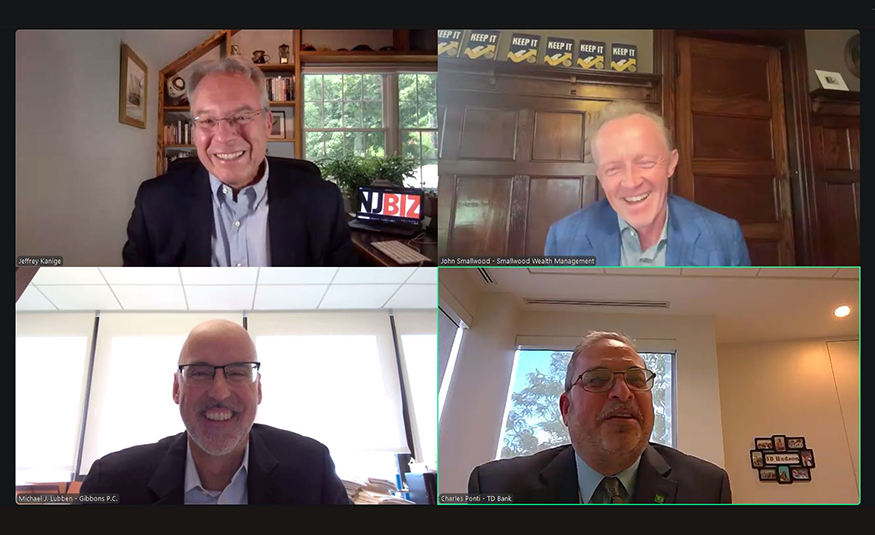The basics:
- Banking and finance panel explores interest rates, lending, M&A, real estate and more
- AI adoption in banking, law and wealth management accelerates
- Experts warn of rising fraud, spoofing and cybersecurity risks
- TD Bank, Gibbons PC and Smallwood Wealth experts share strategies
NJBIZ recently convened its latest panel discussion, featuring a group of notable experts discussing banking and finance trends. The discussion, moderated by NJBIZ Editor Jeffrey Kanige, featured:
The 90-minute discussion opened with an analysis of the interest rate environment – including key trends in real estate and M&A and what happens next. (See, “NJBIZ panel explores rates, real estate and banking outlook” here). After discussing the Trump tax bill and tariffs – and some of the impacts and trends being seen there – the conversation shifted to technology.
AI effects
“I wanted to move on to technology and the kind of effects that those are having on the issues that we’re talking about,” said Kanige. “And I wanted to start with Michael, particularly about artificial intelligence. Because I was talking to a colleague of yours a few weeks ago – just in terms of how the law firm goes about doing its business. And that, clients now are sort of demanding that lawyers employ artificial intelligence and use it in a way that helps them reduce costs and things like that.
“Is that what you’re seeing? Is that similar to your experience – and if not, what’s the difference? What are you hearing from clients about using technology and, particularly, AI?” Kanige asked.
Lubben said it’s been a very rapid transition.
“A year ago, clients were like – don’t use an AI. Now they’re – how come you’re not using AI? Or why can’t you do this a lot quicker and turn that document back, or get me a summary – just use AI,” said Lubben. “There’s expectations, I think, to incorporate it, maybe not realistic completely yet. And I think some people are just better – and even here at the firm – some are using it much more robustly and efficiently and in a safe manner.”
He stressed that if you put something out on ChatGPT, it’s out there for the world.
“And I think it goes into that open database. That’s not anything that we do. You need to have kind of an internal, secure AI program, which we have here,” Lubben continued. “So, it’s a transition right now. But there’s definitely, I think, an expectation — and even some clients have sent over draft term sheets and project proposals, pitches that they’re working on, that they were completely created with AI. And there’s issues with it, but it’s a good start, sometimes. And we’re all learning on the fly, I guess, in certain respects.”


“That was the next question I was going to ask you, though. If the clients are asking you to use it – they must be using it too. And I’m wondering if, especially in the businesses you deal with, particularly real estate – whether the use of AI has spread to the point where it’s actually having an effect on how those folks and how your clients do business – and the way they make decisions?” Kanige asked.
“Yeah – definitely. And, particularly, in M&A and due diligence. Our much larger clients have their own internal platforms, or they bought AI products that they’re using; they want you to use,” he explained. “The smaller ones, I think, are probably just going to Copilot or ChatGPT and First Draft. But as I mentioned, on a real estate project I’m working on, the client used AI to develop a huge project proposal with pictures and numbers and financial information – that looks fairly professional.”
Clients expect quicker responses
“Charles, same sort of question to you about what you’re hearing from the businesses that you deal with. First of all, what is the bank’s policy on AI – and how do you use it?” Kanige asked Ponti. “And second, how is it affecting the way you do business and the way your clients and customers do business?”
Ponti pointed to a 2018 acquisition that TD Bank made of Layer 6.
“And that’s really become our own AI research and development center, so they do quite a lot of work in that regard,” he explained. “It would be an understatement to say that our clients expect quicker, faster responses, and omnichannel delivery from us, mobile, digital. They want to be served however they want to be served.”
He said because of that reality, TD Bank uses AI as much as it can to get rid of the manual tasks – and make them quicker and more efficient.
Replay: Trends in Banking & Finance
Click through to register to watch the full panel discussion!
“That actually would free up time for us, the relationship management part of the team, to spend time with the clients and make suggestions – and give them more an advisory capacity than be doing manual tasks,” he continued. “Some of the things that I know we do now is even in our call center. So, if you call our call center, they’re utilizing a virtual assistant to help those call center operators move through the queue much quicker.
“And then you can use it across all lines of business. You go to something as simple as that. And then, our investment banking folks are using it – the analysts to do equity analysis. So, there’s a wide range of uses for it, and we’re trying to apply it as much as we can.”
The human touch
But Ponti stressed that those efforts are being deployed while also maintaining that human touch.
“Humanity needs to still be human. You see some of our TV commercials – we say, bank human,” said Ponti. “We still want to always maintain that aspect of it, but also acknowledging, both the need and the way that will continue to evolve. And the speed in which it continues to evolve. But to help increase efficiency and get some of the manual tasks out of the way for us.”
“And the human touch – that’s a recurring theme whenever we talk about AI and using it, is that you do need to have people continue to be involved,” said Kanige. “John, I just want to hear from you about what you’re seeing with the folks you work with – and your own business.”


Smallwood said, “If you think about where we are compared to where we were just two years ago – the amount of efficiency gains that have happened as a result of deploying specific technology into firms is exponential, right? So, the way I’m kind of viewing this is, you have an AI-enhanced person. And that AI-enhanced person can actually use the tools, and we use tools in our meetings every day. Where they’re internal. They are very secure. The meeting notes are incredibly detailed to the sentiment of the meeting; who spoke less, who spoke more, who had fear, who had concern, etc.
“Picking up on keywords that we could have never picked up on, but then it syncs with the CRM [customer relationship management] system, and all those meeting notes and actions are pulled out. We’ve got six wealth advisors here. It’s saving probably 40–50 hours a week of just: what did we say we were going to do?”
Investing in AI
Smallwood also pointed to the amount of capital that is pouring into AI and AI enhancement.
“I think the investments are unlike anything that you’ve seen. I mean, you see large corporations who were slow to the game, acquiring and buying companies and acquiring people out for pay packages that you’ve never seen before – because they’re behind. And I really believe every function in a business can be improved through the use of AI, not necessarily replace, but also resize.
“Like you did something for the last 20 years. Okay – if I can now have AI help me do my job. Now I can do 10 times that, how much more efficient does the business get? How much more profitable can we get with the same people, or more people, and work into markets that we could have not worked into because we’re looking at things differently? I think five years from now, we’re sitting here going – oh my God, can you believe what has happened as a result of AI enhancement?”
And I really believe every function in a business can be improved through the use of AI, not necessarily replace, but also resize.
– John Smallwood, president and CEO, Smallwood Wealth Management
Potential pitfalls
From there, the conversation moved to the potential pitfalls and dangers of these rapidly evolving technologies, particularly pertaining to fraud and cybersecurity.
Lubben spoke about the trends he sees in the transactions his firm works on.
Thoughts on interest rates and lending
The NJBIZ panel weighed in on the current monetary policy environment and its effects on business and the economy. Here is a selection of their points.
Charles Ponti
“I think people got so used to rates being near zero – that any jump from there was a bit of, potentially, a sticker shock for them. But if you look historically, they’re not really extraordinarily inflated at this point … I think, in combination, however, with some higher interest rates and a general overall economic uncertainty, it has slowed some borrowers down. Demand has somewhat been tempered. … [W]e are envisioning a decrease in rates, in the near term. Our forecast is for a cut starting in September and moving [forward] a couple of more cuts – three in total – by the end of the calendar year.”
John Smallwood
“When you think about the interest rates, where they are, and the speed at which they came from – that floor, that very low historical level – and the speed that they went up; that impacted a lot of things. And we’re starting to see the residual byproducts of that. We’re seeing housing markets starting to get some supply. … So, when you look at markets, typically, you overshoot, you undershoot. And I think we’re in an overshoot position – where the natural conversation is in the 3.5% to 3.8% range. And I think that gets you to your money in the bank still makes money, which is a huge problem.”
Michael Lubben
“[T]hings are getting better because a lot of the transactions that I work on are priced off of term SOFR [Secured Overnight Financing Rate]. And if you look a year ago, term SOFR was 5.3 or so – and today, it’s right around 4.3. It’s been holding fairly steady since January. So, that drop – one point – but it’s been a significant assist in getting deals done. … And we actually just closed … two significant construction loans totaling over a few hundred million dollars together for residential development. And I think a lot of it just has to do with the fact that there’s certain markets in the country, and specifically in New Jersey, where you can still get appetite from lenders to lend into those deals – because there is such a strong demand for housing in our area right now.”
“Given what’s happening today compared to two or three years ago, you could see that everybody in the chain of these transactions is much more vigilant than they had been in the past,” said Lubben. “People are calling people up to get wire callback information. There’s secure links with wire information anywhere money is being transferred.
“But with AI, the ability to replicate voices and faces and videos, it’s just going to be a constant challenge, I think, for everyone to continue to keep up with the hackers. Because they’re really just getting much more elaborate.”
Ponti stressed that fraud is everywhere.
“The bank security used to think, in the old days, you were worried about someone coming in and passing a note and robbing the bank,” he said. “Now, it’s unbelievable the schemes that the fraudsters come up with and spoofing. We hear from clients all the time that they’re spoofing. Not just us – it’s pervasive throughout the industry. Spoofing telephone numbers and calling trying to get their sign-on credentials to their online banking.
“So, it’s an education, too, for our clients – that we need to educate them. And they need to educate their teams, that they have to be ever vigilant.”
Smallwood said fraud schemes and attacks are coming from many different areas. “Everything that you do, whether you’re online or not, is a transaction that’s done online,” he explained. “In our firm, we have a massive cyber initiative where we’re constantly, our consultants are constantly testing and baiting our employees. And there’s continual things – our vendors are testing us.
“It is one of the most important things. But you as the individual – you’ve got to make sure that you’ve taken the right precautions in your emails, in your things, and that you’re sending things secure,” said Smallwood. He pointed to features like two-factor authentication as critical.
Smallwood also noted that the ways fraudsters are coming at individuals and businesses are evolving in a number of different ways.
“It used to be the phone calls, and now it’s emails and it’s texts and it’s all kinds of things,” he explained. “It’s easier, but yet harder — but yet it’s more pervasive. Because they’re coming after, not just the institutions – they’re coming after the individuals.
“So, it’s always been around in different formats,” said Smallwood, who noted that the number of impressions people are getting is growing by a large scale. “And it’s a concern. But it’s also – not everybody’s a bad actor. But the good actors need to be really good, and they need to button down things.
“And you need to make sure that your awareness is up.”







